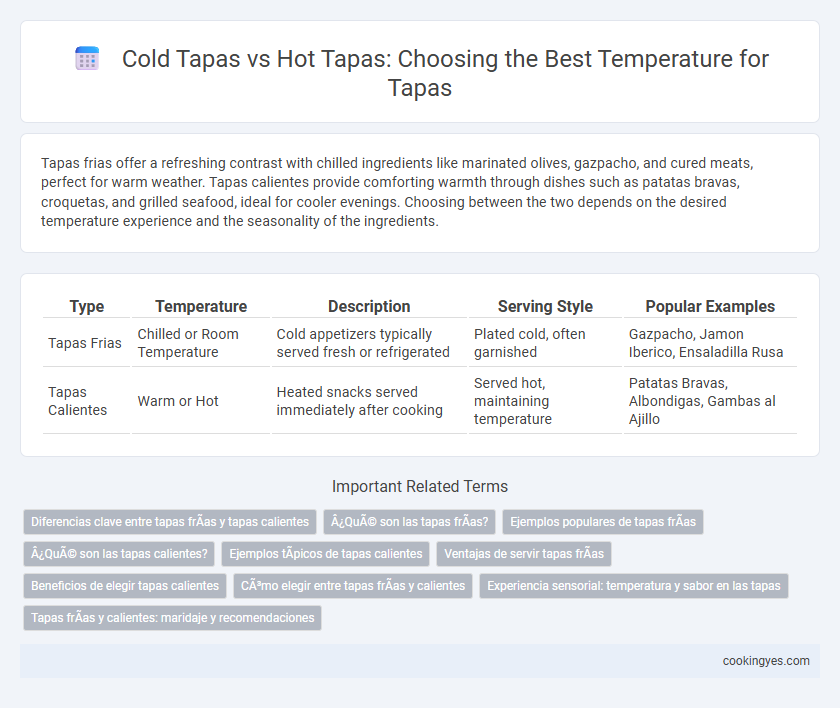Tapas frias offer a refreshing contrast with chilled ingredients like marinated olives, gazpacho, and cured meats, perfect for warm weather. Tapas calientes provide comforting warmth through dishes such as patatas bravas, croquetas, and grilled seafood, ideal for cooler evenings. Choosing between the two depends on the desired temperature experience and the seasonality of the ingredients.
Table of Comparison
| Type | Temperature | Description | Serving Style | Popular Examples |
|---|---|---|---|---|
| Tapas Frias | Chilled or Room Temperature | Cold appetizers typically served fresh or refrigerated | Plated cold, often garnished | Gazpacho, Jamon Iberico, Ensaladilla Rusa |
| Tapas Calientes | Warm or Hot | Heated snacks served immediately after cooking | Served hot, maintaining temperature | Patatas Bravas, Albondigas, Gambas al Ajillo |
Diferencias clave entre tapas frías y tapas calientes
Tapas frias typically include dishes served at room temperature or chilled, such as gazpacho, jamon serrano, or marinated vegetables, offering a refreshing and light dining option. Tapas calientes are cooked and served warm, featuring items like croquetas, albondigas, or gambas al ajillo, providing a more comforting and hearty experience. The key differences lie in the serving temperature and preparation methods, influencing texture, flavor intensity, and pairing possibilities with wines or beverages.
¿Qué son las tapas frías?
Tapas frias are Spanish appetizers served cold or at room temperature, featuring ingredients like cured meats, cheeses, marinated seafood, and fresh vegetables. These dishes emphasize fresh, vibrant flavors without requiring heating, making them ideal for warm weather and quick preparation. Popular examples include gazpacho, ensaladilla rusa, and jamon serrano with melon.
Ejemplos populares de tapas frías
Tapas frias, favored in warm climates or during summer, include popular examples like gazpacho, salmorejo, and marinated olives that are served chilled to enhance freshness and flavor. These cold tapas contrast with tapas calientes, such as patatas bravas or albondigas, which are typically served hot to bring out rich, savory aromas. The temperature difference in these dishes highlights the versatility of Spanish tapas, offering a refreshing variety for different palates and occasions.
¿Qué son las tapas calientes?
Tapas calientes are traditional Spanish small dishes served warm, offering a comforting and rich flavor profile compared to tapas frias, which are served cold and emphasize freshness. Common examples of tapas calientes include patatas bravas, croquetas, and gambas al ajillo, highlighting the importance of temperature in enhancing texture and taste. This contrast in serving temperature differentiates the dining experience, as tapas calientes provide a cozy, savory sensation ideal for cooler weather or hearty appetites.
Ejemplos típicos de tapas calientes
Tapas calientes typically include dishes like albondigas (meatballs in sauce), croquetas de jamon (ham croquettes), and gambas al ajillo (garlic shrimp), which are served warm to enhance their rich flavors and textures. These hot tapas contrast with tapas frias such as gazpacho or tortilla espanola served at room temperature or chilled, providing a variety of temperature experiences in Spanish cuisine. Heating certain ingredients unlocks deeper umami and aromatic profiles crucial to traditional hot tapas dishes.
Ventajas de servir tapas frías
Tapas frias offer the advantage of easy preparation and prolonged freshness, making them ideal for events where maintaining temperature control is challenging. They allow for a diverse array of flavors such as marinated vegetables, cured meats, and chilled seafood that appeal to a broad palate without the risk of temperature loss affecting quality. Serving tapas frias reduces the need for heating equipment and minimizes the risk of overcooking, ensuring consistent taste and texture.
Beneficios de elegir tapas calientes
Tapas calientes offer significant health benefits due to their warm preparation, enhancing nutrient absorption and digestion compared to cold tapas frias. The heat in tapas calientes can improve circulation and boost metabolism, promoting better energy utilization in the body. Choosing tapas calientes often results in richer flavors and aromas, which can increase meal satisfaction and encourage mindful eating habits.
Cómo elegir entre tapas frías y calientes
Choosing between tapas frias and tapas calientes depends on the desired dining experience and temperature preference; tapas frias offer refreshing flavors with ingredients like gazpacho, marinated olives, and cured meats served chilled, perfect for warm weather. Tapas calientes provide comforting warmth with dishes such as patatas bravas, croquetas, and grilled seafood, ideal for cooler climates or evening meals. Balancing these options enhances the meal by combining contrasting temperatures and textures for a satisfying Spanish tapas experience.
Experiencia sensorial: temperatura y sabor en las tapas
Tapas frias offer a refreshing and crisp sensory experience, enhancing delicate flavors through chilled temperatures that highlight freshness and subtle textures. Tapas calientes intensify taste complexity by combining warmth and heat, which releases aromatic oils and deepens savory notes, creating a comforting and robust flavor profile. The contrast between cold and hot tapas enriches the overall gastronomic journey, balancing temperature-driven taste sensations and mouthfeel for a dynamic dining experience.
Tapas frías y calientes: maridaje y recomendaciones
Tapas frias, such as gazpacho and marinated olives, are ideal for pairing with crisp white wines or light sherries that enhance their refreshing flavors and cool temperature. Tapas calientes, including patatas bravas and albondigas, complement robust red wines or dry fino sherries, which balance the warmth and rich spices. For optimal maridaje, serve tapas frias chilled to preserve texture and aroma, while tapas calientes should be served hot to highlight their bold and savory profiles.
Tapas frías vs Tapas calientes for temperature Infographic

 cookingyes.com
cookingyes.com